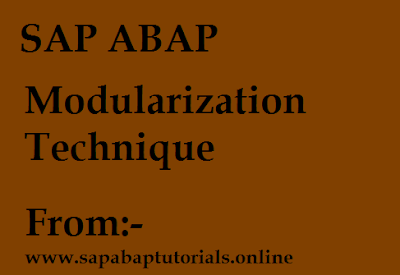MODULARIZATION TECHNIQUES
Modularization is the
process of breaking the program into multiple blocks.
A block is a
set/collection of statements which is defined only once and can be called / accessed
any no. of times.
Advantages of Modularization:
·
Increases re-usability.
·
Efficient control on the
flow of program execution.
·
Maintenance cost is
decreased.
Following are the Modularization techniques:
·
Subroutines
·
Include programs
·
Macros(HR-ABAP)
·
Function modules
·
Methods(OOPS ABAP)
Subroutines:
It is a block of statements,
which is defined only once and can be called any number of times.
Subroutine can be
created either with parameters or without parameters.
A subroutine is
associated with 2 sections.
·
Defining the subroutine
·
Calling the subroutine
Subroutine as to be
defined at the end of the program.
Whenever a subroutine
is called the control jumps to subroutine definition.
There are two types of subroutines.
·
Internal subroutine
·
External subroutine
Internal subroutine:
It is defined as well
as called from the same program.
Syntax
for defining internal/external subroutine:
Form
<subroutine> [ parameters list]
statements.
Endform.
Syntax for calling internal subroutine:
perform
<subroutine> [parameters list]
External
subroutine:
They are defined in
external programs and called from other programs.
The external program
can be another executable program or a subroutine pool.
Subroutine
pool:
It is a repository
object which is a collection of one or more external subroutines
Syntax
for calling external subroutines:
Syntax
1
Perform
<subroutine> in program <external program> [parameters list].
Syntax
2
Perform
<subroutine> (<external program>) [parameters list].
Subroutines
with parameters (for data exchange and manipulation)
We can define subroutines
with parameters.
For this we use the
following keywords.
1.
Using
2.
Changing
3.
Tables
The parameters specified
as part of subroutine definition are called as formal parameters and the
parameters specified at the time of calling the subroutine are called as actual
parameters.
Using:
Using is the keyword used
as part of subroutine definition and subroutine calling to deal with standard
data types as parameters.
The formal parameters and
actual parameters names can be same or different.
The number of formal
parameters depends upon the number of actual parameters.
Subroutines
returning values:
For this we can use the
keywords changing or tables.
The number of return
parameters depends upon number of changing and tables parameters.
The changing and tables
parameters can be used for both passing the values as well as returning the
values.
We can pass parameters to
subroutines in two ways.
1.
Pass by reference (default).
2.
Pass by value.
In this, the address of
actual parameters are copied to formal parameters. So, any changes made to the
formal parameters variables will automatically reflect the content of the
actual parameters.
Pass
by value:
In this, the values of
actual parameters are copied to formal parameters. So, any changes made to the
data of formal parameters will not reflect the content of the actual
parameters. For this, we need to use the keyword ‘value’ as part of formal
parameters.
Internal
tables as parameters to subroutines:
We need to use tables
keyword as part of subroutine call and subroutine definition to deal with
internal tables as parameters to subroutines.
In this case, if we
perform the operations like delete and modify on formal internal table with
where clause, we must specify the structure of the formal internal table and it
is done by using the keyword structure
as part of subroutine definition.
In this case, any changes
made to the data of the formal internal table, will automatically reflect
actual internal table data.
Internal tables are
always passed by reference.
Note:- If anybody want some example of these all topic then kindly send/comment your mail id, i will send the all examples through mail in word format.
**Kindly like and share these all topic with your friends**



0 Comments